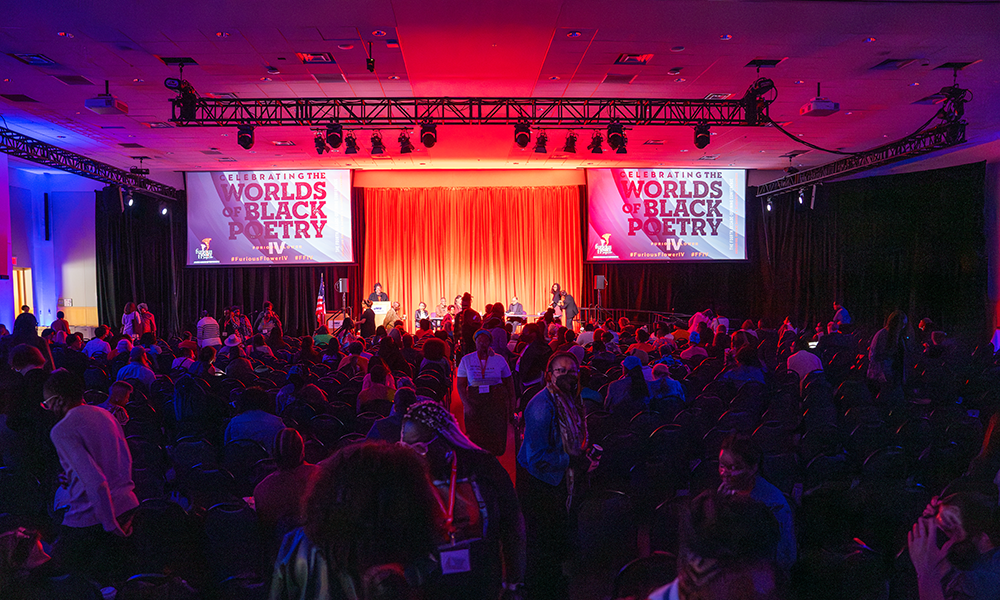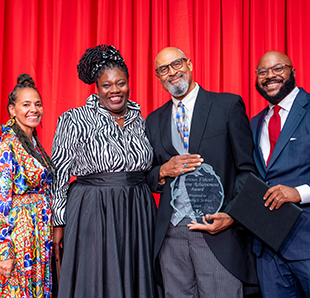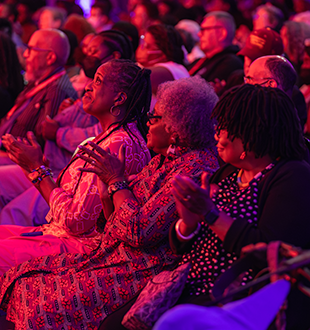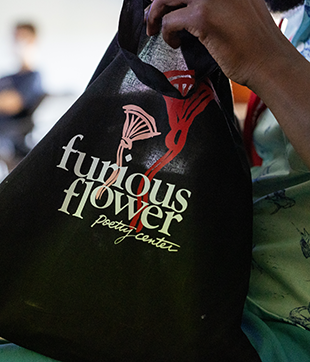Savoring Furious Flower IV: The Worlds of Black Poetry
News
SUMMARY: The fourth-ever Furious Flower Poetry Conference, held once a decade, took place at James Madison University in Harrisonburg, Virginia this past September under the theme “The Worlds of Black Poetry.”
The fourth-ever Furious Flower Poetry Conference, held once a decade, was like a slow-cooked meal — rich and deeply nourishing. Led by executive director Lauren K. Alleyne and her team, and sponsored by the Mellon Foundation, Amazon Literary Partnership and multiple JMU partners, the event took place at James Madison University in Harrisonburg, Virginia this past September under the theme “The Worlds of Black Poetry.”
Since its inaugural conference in 1994, when Joanne Gabbin brought together thirty eminent poets to honor American poet and writer Gwendolyn Brooks, the Furious Flower Poetry Center has grown into a cornerstone of Black poetic culture. Now a decennial celebration, the gathering takes a reflective view of Black poetics, highlighting the shifts and continuities in the tradition across generations. The 2024 conference marked another momentous chapter in this ongoing story by highlighting Black global and diasporic poets and poetry.

Furious Flower IV paid tribute to two towering figures in the field: Elizabeth Alexander and Kwame Dawes. Their contributions to the Black poetic canon and to the cultivation of younger voices set the tone for the event’s intergenerational and international ethos. The Lifetime Achievement Award ceremony on the first night of the conference honored the achievements of Alexander, Dawes and eight other poets: Cornelius Eady, Nikky Finney, Lorna Goodison, Niyi Osundare, Tim Seibles, Patricia Smith, Harryette Mullen and Ethelbert Miller. The honorees emphasized that Black poetry is a shared inheritance — a continuum of voices that thrive in dialogue with one another.
That inheritance was on full display at the conference which featured a total of 50 poets. The four “Black Universe” readings included luminaries like MacArthur “Genius” award winners Jericho Brown and Terrance Hayes; former U.S. and Virginia Poet Laureate Rita Dove; and renowned international poets Niyi Osundare (Nigeria), Patricia Jabbeh Wesley (Liberia) and Merle Collins (Grenada). Abundance, a two-part virtual showcase, featured 13 global Black poets from 10 different countries.
The conference’s more than 70 concurrent sessions provided a space where scholars explored innovative topics related to Black poetry, examining its global dimensions and various facets. At the “Seeds and Stars” open mic sessions, both emerging and seasoned poets took the stage, sharing their work in an atmosphere brimming with camaraderie and inspiration.

In addition to the abundant poetry readings and scholarly panels, the conference hosted gallery exhibitions and performances. Each element explored the intersections of identity, history, and artistic expression. The Lisanby Museum’s exhibit Worlds Within and Without: An Exhibition of Contemporary Black Art, sponsored by the Art Bridges Foundation, featured internationally renowned Black artists including Mickalene Thomas, David Hammons and Senga Nengudi. The broadside exhibit, curated by Furious Flower graduate assistants Haylee Chase Edwards and Nikema Bell, showcased “the work of diasporic poets who recollect and reassemble the hurt, connect with the histories that have been dispersed, and initiate cultural healing.”
Minia Biabiany’s dlo a rasin (Water from the Roots) exhibit at Duke Gallery extended this theme into environmental activism, using hanging installations and informational videos to connect the legacies of colonialism with urgent ecological crises. Country music singer/songwriter Britteny Spencer closed the conference with a concert at JMU’s Forbes Center. These performances and visual art installations, in conversation with the poetry, showed how Black creativity flows across media, generating dialogues about justice, memory and possibility.
 The impact of the conference is felt both locally and around the world. The more than 700 conference participants included attendees from around the country, as well as from a variety of international locations, including England, Poland, Australia, Jamaica and Canada. They also included over 300 JMU faculty, staff and students. In the conference’s opening session, CAL Dean Traci Zimmerman shared her experience while a graduate student attending the first Furious Flower Poetry Conference in 1994 as marking a turning point in her educational and career trajectory. She noted JMU’s fortune in being home to such a vital cultural and interdisciplinary institution.
The impact of the conference is felt both locally and around the world. The more than 700 conference participants included attendees from around the country, as well as from a variety of international locations, including England, Poland, Australia, Jamaica and Canada. They also included over 300 JMU faculty, staff and students. In the conference’s opening session, CAL Dean Traci Zimmerman shared her experience while a graduate student attending the first Furious Flower Poetry Conference in 1994 as marking a turning point in her educational and career trajectory. She noted JMU’s fortune in being home to such a vital cultural and interdisciplinary institution.
Furious Flower IV was not just a celebratory gathering; it was also a reminder that Black poetry is more ecosystem than monolith, its intersecting microworlds each enduringly vital. The scholarship, art and poetry shared at the conference will continue to shape dialogues about Black literature and culture for years to come. That rich blend of legacy, innovation and communal joy is the foundation for the Furious Flower Poetry Center and its decennial events. With great anticipation, we look forward to the 2034 gathering, which, like a great meal, will be worth the wait.
To experience moments of the conference, visit the Furious Flower YouTube channel, and listen to our Furious Flower IV podcast available on Soundcloud and Apple Podcasts.
